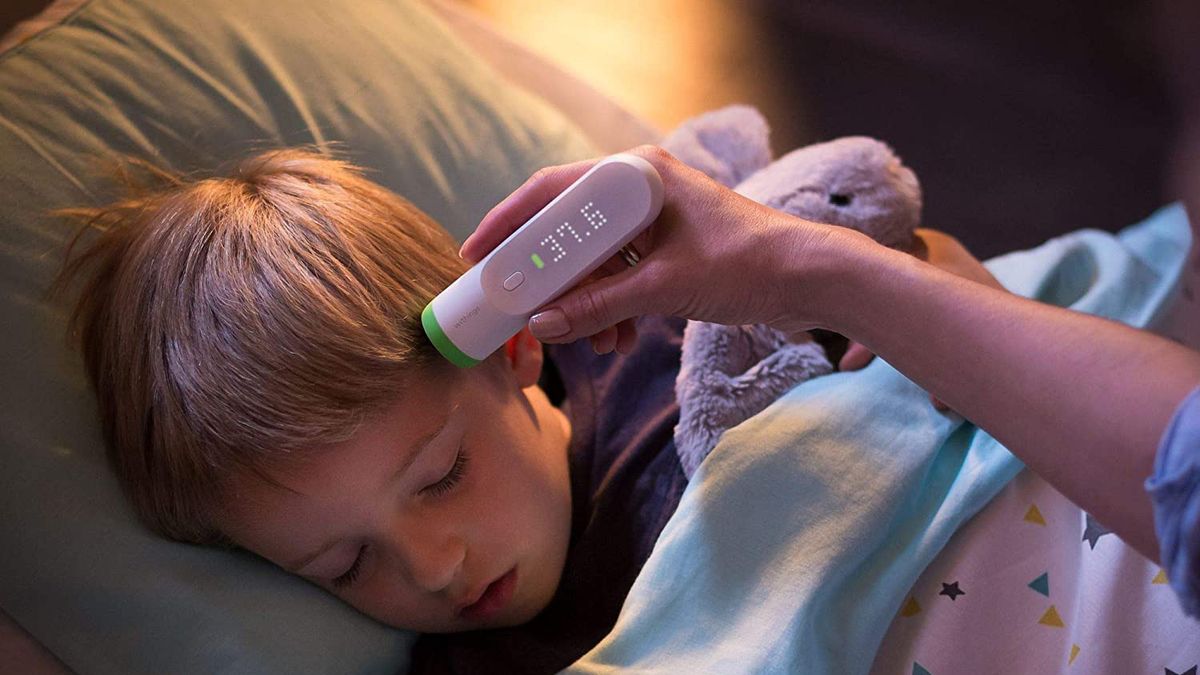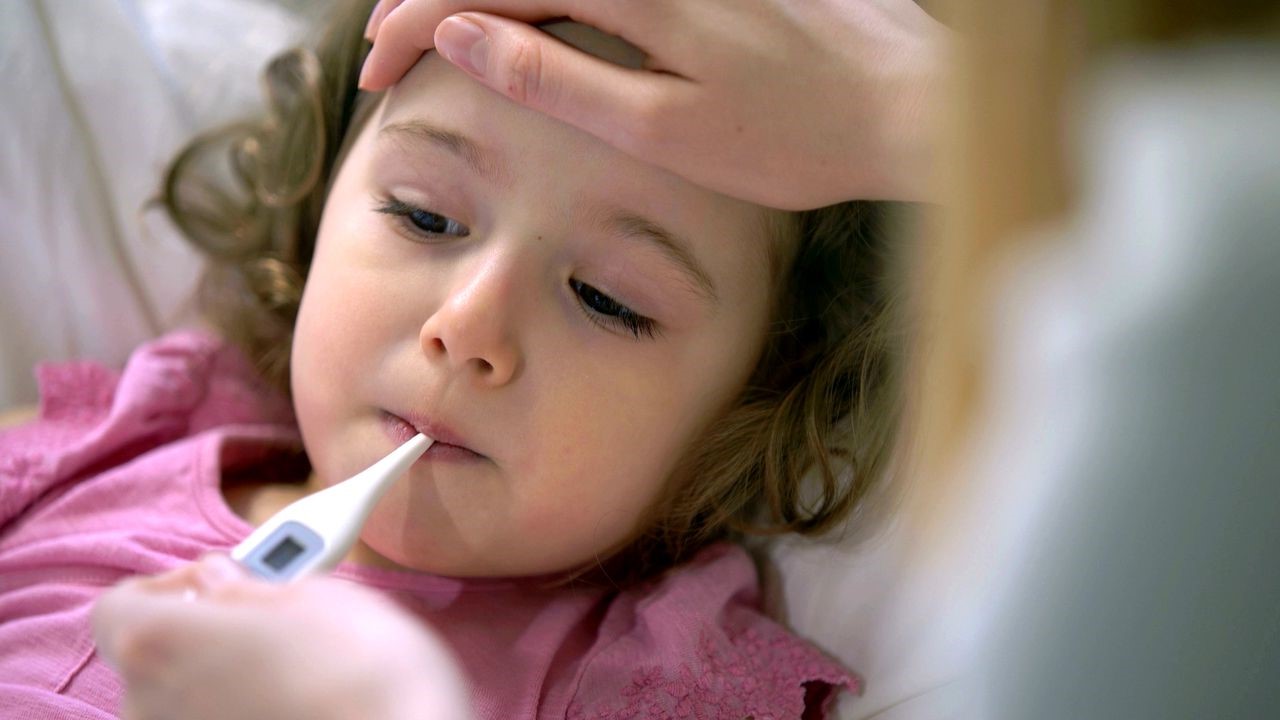Home>Health & Nutrition>Ideal Fever Temperature For Children


Health & Nutrition
Ideal Fever Temperature For Children
Published: February 19, 2024
Learn about the ideal fever temperature for children and how to manage it. Get expert advice on health and nutrition for your little ones.
(Many of the links in this article redirect to a specific reviewed product. Your purchase of these products through affiliate links helps to generate commission for Temperatures.com, at no extra cost. Learn more)
Table of Contents
Understanding Fever in Children
Fever is a common concern for parents, often causing worry and anxiety. However, it's important to understand that fever is not an illness in itself, but rather a sign that the body is fighting off an infection. In children, a fever is usually considered a body temperature of 100.4°F (38°C) or higher. It's the body's natural response to infections, stimulating the immune system to combat the underlying cause.
When a child's body detects the presence of a virus or bacteria, it releases chemicals called pyrogens, which act on the hypothalamus in the brain, raising the body's temperature. This elevated temperature creates an environment that is less favorable for the growth and reproduction of the invading pathogens, aiding the body's defense mechanisms.
Understanding the level of fever is crucial. Low-grade fevers, ranging from 100.4°F to 102.2°F (38°C to 39°C), are often caused by common viral infections and can be managed at home with rest and fluids. On the other hand, high fevers, exceeding 102.2°F (39°C), may indicate a more serious infection and require medical attention.
It's important to note that fever itself is not harmful, and in fact, it plays a beneficial role in the body's defense against infections. However, it can cause discomfort and distress in children. Therefore, it's essential for parents to monitor their child's fever and take appropriate measures to alleviate their discomfort.
Understanding the nature of fever in children can help parents approach it with a calmer mindset, knowing that it is often a sign that the body is actively fighting off an infection. By closely monitoring the child's temperature and observing their overall condition, parents can make informed decisions about when to seek medical attention and when home care is sufficient.
Factors Affecting Ideal Fever Temperature
The ideal fever temperature for children can be influenced by various factors, impacting the body's response to infections and the manifestation of fever. Understanding these factors is crucial for parents and caregivers in assessing the severity of a child's fever and determining the appropriate course of action.
-
Age: The age of the child plays a significant role in determining the ideal fever temperature. Infants and young children tend to have higher baseline temperatures compared to older children and adults. Therefore, what may be considered a mild fever in an older child could be more concerning in an infant.
-
Underlying Health Conditions: Children with pre-existing health conditions, such as immune system disorders or chronic illnesses, may have different ideal fever temperatures. These conditions can affect the body's ability to regulate temperature and respond to infections, leading to variations in fever thresholds.
-
Vaccination Status: The vaccination status of a child can impact their ideal fever temperature. Some vaccines can cause low-grade fevers as a normal immune response. Understanding the timing of vaccinations and potential side effects can help parents differentiate between vaccine-related fevers and those caused by infections.
-
Environmental Factors: External factors, such as ambient temperature and humidity, can influence a child's ideal fever temperature. Hot weather or overdressing can elevate body temperature, potentially leading to false interpretations of fever. Conversely, cold environments can cause shivering, which raises body temperature as a natural response to generate heat.
-
Individual Variations: Each child's body may respond differently to infections, resulting in variations in ideal fever temperatures. Factors such as metabolism, hydration levels, and genetic predispositions can contribute to individual differences in fever responses.
-
Medication Use: The use of certain medications, such as antipyretics (fever-reducing drugs), can affect the body's ability to generate and regulate fever. Understanding the timing and dosage of medications is essential in accurately assessing a child's fever temperature.
By considering these factors, parents and caregivers can gain a more comprehensive understanding of the ideal fever temperature for their child. This knowledge empowers them to make informed decisions regarding fever management and when to seek medical advice based on the individual characteristics and circumstances influencing their child's fever.
Importance of Monitoring Fever in Children
Monitoring a child's fever is a critical aspect of parental care and plays a pivotal role in ensuring the child's well-being during episodes of illness. The significance of closely monitoring a child's fever cannot be overstated, as it provides valuable insights into the body's response to infections and guides the appropriate course of action. Here's why monitoring fever in children is of utmost importance:
Early Detection of Serious Infections
By diligently monitoring a child's fever, parents and caregivers can promptly identify any concerning trends or patterns in the temperature elevation. This early detection can be instrumental in recognizing potentially serious infections that may require medical intervention. High or persistent fevers can be indicative of bacterial infections, such as urinary tract infections or pneumonia, which necessitate timely medical assessment and treatment. Therefore, vigilant monitoring enables early detection of alarming fever patterns, allowing for timely medical attention and intervention.
Assessment of Overall Well-being
Fever monitoring extends beyond simply recording temperature readings. It involves observing the child's overall well-being, including their behavior, hydration status, and responsiveness. By closely monitoring a child's fever, parents can assess whether the child is displaying signs of distress, such as excessive irritability, lethargy, or difficulty breathing. These observations provide crucial indicators of the child's overall condition and aid in determining the severity of the illness. Additionally, monitoring fluid intake and urine output during fever episodes is essential for evaluating the child's hydration status, which is particularly critical during illness.
Informed Decision-Making
Regular monitoring of a child's fever empowers parents and caregivers to make informed decisions regarding the appropriate management of the fever. By tracking temperature trends and observing the child's symptoms, caregivers can determine whether the fever is responding to home care measures or if medical attention is warranted. This informed decision-making process is essential in providing the best possible care for the child, ensuring that appropriate interventions are implemented at the right time.
Communication with Healthcare Providers
Accurate and consistent fever monitoring provides healthcare providers with essential information when seeking medical advice or treatment. When seeking medical assistance, the ability to provide detailed and precise fever-related data, including temperature trends, associated symptoms, and the child's overall condition, facilitates more effective communication with healthcare professionals. This, in turn, enables healthcare providers to make well-informed assessments and recommendations, leading to improved care and outcomes for the child.
In essence, the importance of monitoring fever in children cannot be overstated. It serves as a fundamental aspect of parental responsibility, enabling early detection of serious infections, assessment of the child's overall well-being, informed decision-making, and effective communication with healthcare providers. By diligently monitoring a child's fever, parents and caregivers play a proactive role in safeguarding the child's health and well-being during episodes of illness.
Recommended Methods for Measuring Fever in Children
Accurately measuring a child's fever is essential for proper assessment and management of their health. Several reliable methods can be employed to measure a child's body temperature, each offering distinct advantages and considerations. Understanding the recommended methods for measuring fever in children equips parents and caregivers with the knowledge to obtain accurate temperature readings and make informed decisions regarding the child's care.
Rectal Thermometry
Rectal thermometry is considered the gold standard for measuring body temperature in infants and young children. While it may be perceived as invasive, it provides the most accurate representation of core body temperature. To perform rectal thermometry, a digital thermometer is gently inserted into the child's rectum, and the reading is obtained after a brief period. This method is particularly recommended for infants under three months of age, as their immune systems are still developing, and accurate temperature assessment is crucial.
Read more: The Ideal Temperature Range For Dogs
Oral Thermometry
For older children who can safely and effectively cooperate, oral thermometry is a reliable method for measuring body temperature. The child is instructed to place the thermometer under their tongue, ensuring that they keep their mouth closed during the reading. It is important to note that this method is not suitable for young children or those who are unable to follow instructions, as it requires the child to keep the thermometer in place for an extended period.
Axillary Thermometry
Axillary, or underarm, thermometry is a non-invasive method commonly used to measure a child's temperature. While it is convenient and comfortable for the child, it is important to ensure proper technique to obtain accurate readings. The thermometer is placed in the child's armpit and held in position until the reading is complete. This method is suitable for children who are unable to cooperate with oral thermometry or for quick, preliminary temperature assessments.
Tympanic Thermometry
Tympanic thermometry involves using a specialized thermometer to measure the child's temperature through the ear canal. This method is particularly useful for young children and infants, as it provides a quick and non-invasive way to obtain temperature readings. However, it is essential to position the thermometer correctly to ensure accurate results. Tympanic thermometry is convenient for parents and caregivers, especially when dealing with fussy or uncooperative children.
Forehead Thermometry
Forehead thermometers, also known as temporal artery thermometers, offer a non-invasive and hygienic method for measuring a child's temperature. These thermometers are gently swiped across the child's forehead, capturing the infrared heat emitted by the skin to determine body temperature. While convenient and suitable for quick assessments, it is important to follow the manufacturer's instructions to ensure accurate readings.
Read more: Ideal Temperature Range For Guinea Pigs
Considerations for Method Selection
When selecting a method for measuring a child's fever, several factors should be considered, including the child's age, level of cooperation, and the desired level of accuracy. Additionally, it is crucial to follow the manufacturer's guidelines for each thermometer and to maintain proper hygiene practices to prevent cross-contamination.
By understanding and utilizing the recommended methods for measuring fever in children, parents and caregivers can ensure accurate temperature assessments, enabling them to make informed decisions regarding the child's health and well-being. Regular monitoring of a child's fever using appropriate methods facilitates early detection of concerning temperature trends and supports effective communication with healthcare providers when seeking medical advice or treatment.
When to Seek Medical Attention for a Child's Fever
Determining when to seek medical attention for a child's fever is a crucial aspect of parental responsibility, as it involves assessing the severity of the child's illness and ensuring timely intervention when necessary. While many fevers in children are caused by mild viral infections and can be managed at home, certain circumstances warrant prompt medical evaluation and care. Understanding the red flags and indicators that necessitate medical attention empowers parents and caregivers to prioritize the child's well-being and seek appropriate healthcare support when needed.
Persistent High Fever
A persistent high fever, particularly one that exceeds 102.2°F (39°C) and does not respond to fever-reducing medications, should prompt immediate medical attention. High fevers can be indicative of more serious infections, such as bacterial pneumonia or urinary tract infections, which may require medical assessment, diagnostic testing, and targeted treatment.
Unusual Symptoms or Behavior
Unusual symptoms accompanying the fever, such as severe headache, stiff neck, persistent vomiting, or unexplained rashes, warrant medical evaluation. Additionally, changes in the child's behavior, such as extreme lethargy, irritability, or difficulty breathing, should not be overlooked and may indicate an underlying medical concern that requires professional assessment.
Age-Specific Considerations
For infants under three months of age, any fever, even if mild, should prompt immediate medical attention. Young infants have immature immune systems and are more vulnerable to serious bacterial infections, making prompt evaluation essential. Similarly, for children with pre-existing health conditions or compromised immune systems, any fever should be promptly evaluated by a healthcare provider to rule out potential complications.
Fever with Dehydration
Fever can lead to increased fluid loss through sweating and evaporation, potentially leading to dehydration, especially in young children. If a child with fever shows signs of dehydration, such as decreased urine output, dry mouth, or excessive thirst, medical attention should be sought to address both the fever and the associated dehydration.
Concerns about Febrile Seizures
Febrile seizures, although generally harmless, can be distressing for parents. If a child experiences a febrile seizure for the first time, immediate medical evaluation is recommended to rule out underlying causes and provide guidance on seizure management and prevention.
Parental Instinct and Concern
Ultimately, parental instinct and concern should not be underestimated. If a parent or caregiver feels uneasy about the child's condition, even if the fever appears mild, seeking medical advice and reassurance is entirely appropriate. Healthcare providers understand the importance of parental intuition and are equipped to provide guidance and support based on individual circumstances.
In essence, recognizing the signs that warrant medical attention for a child's fever is essential for ensuring the child's health and well-being. By remaining vigilant and responsive to concerning fever patterns and associated symptoms, parents and caregivers play a proactive role in advocating for the child's health and seeking timely medical intervention when necessary.











